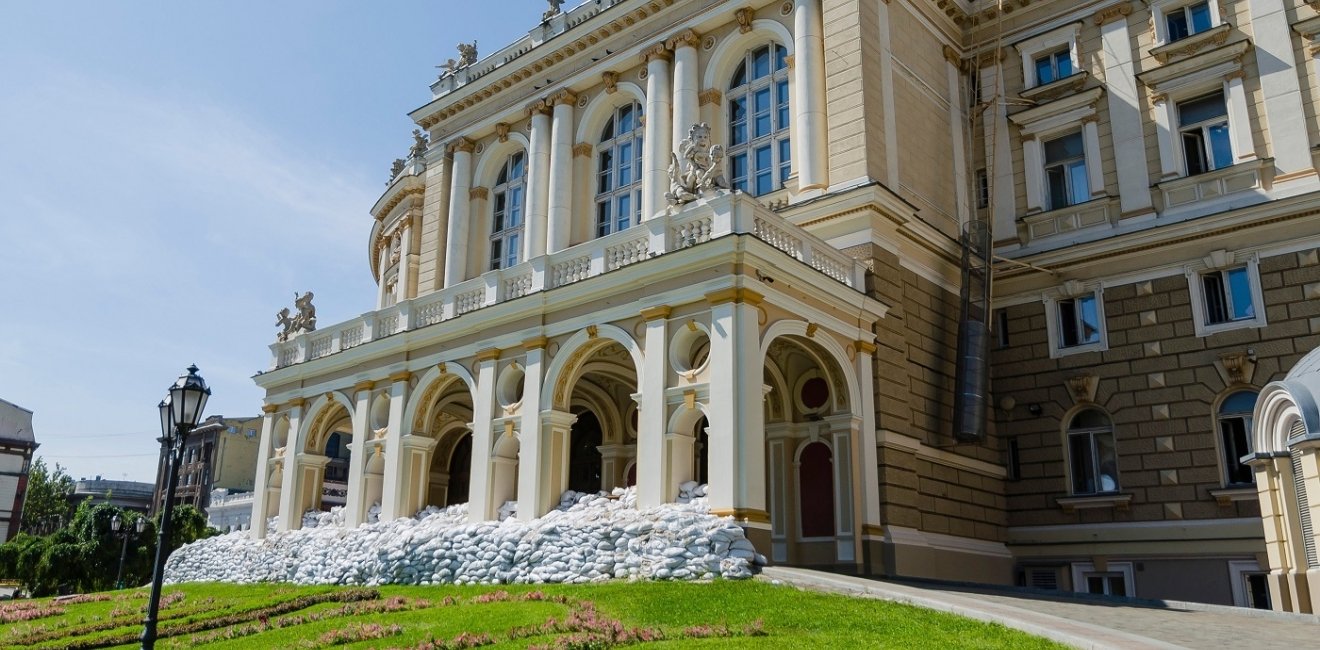
A blog of the Kennan Institute
The Odesa Opera House is “the heart of Odesa,” as Odesa National Academic Opera and Ballet Theater assistant director Lyudmila Serhiychuk told journalist Daniel Ofman of PRX’s The World public radio program in late February. Ofman was drawn to the story when he learned that the theater had reopened only three months after the February 24, 2022, Russian invasion of Ukraine even though Odesa has been subject to Russian attack.
Opera singers and musicians immediately performed in parks and public spaces for those who remained in their city. Within a dozen weeks, they had returned to their home venue to perform for audiences of soldiers, displaced people, and residents who remained in the city (though audiences were restricted to those who could fit in the Opera House bomb shelter). On at least one occasion, the hall was evacuated for an hour as air raid sirens sounded and audience members and performers scurried to the shelter. The performance continued once the all-clear sounded.
Opera houses have emerged as powerful symbolic civic centers over the past year in Odesa, Lviv, and Kyiv. As noted in previous blog posts (see May 24, December 16, and January 27), the theaters reopened as soon as they could, even if on a limited basis to meet martial law and safety requirements. Lviv’s opera company, being further from the front, has been perhaps the most ambitious, offering new works as well as those drawn from its repertoire. In all three cities, performances at these central theaters have become powerful symbols of Ukrainian resolve. Even in Kharkiv, where the Soviet-era opera and ballet theater has been damaged by Russian bombardment, company musicians have gone out into the city to perform in metro stations, bomb shelters, and basements (see posts from April 29, July 22, and March 17).
The role of opera houses as civic symbols might seem anomalous at the outset of the 21st century, yet their history matters. Unlike St. Petersburg and Moscow, where major theaters were run by bureaucracies attached to the imperial household—and even Vienna, where the exigencies of empire similarly ruled—the Odesa, Lviv, and Kyiv opera houses were built by and supported by robust professional and expanding middle classes at the turn of the last century. In contrast to municipal governmental buildings, they represented local pride and power rather than imperial authority imposed from St. Petersburg or Vienna.
This special status as an exemplar of local pride was especially true in Odesa. The current opera house replaced an earlier theater, which opened in 1810 and burned in 1873. The city immediately launched a fundraising campaign as well as an international design competition. Construction began in 1883 along the design prepared by two Viennese architects, Ferdinand Fellner and Hermann Helmer. When completed in 1887, the opera was the first building in the city lit by the Edison Company’s electrical bulbs. The house was soon recognized for its excellent acoustics.
Constructed with privately raised funds collected through a municipal campaign, the Opera House, elegantly grand and centrally located, became a symbol of Odesa’s turn-of-the-century prosperity and eminence. Among Russia’s largest ports at the time, Odesa, with 400,000 residents, was the Russian Empire’s fourth-largest city (behind St. Petersburg, Moscow, and Warsaw). The city’s municipal administration enjoyed the third-largest operating budget of any Russian city, behind only Moscow and St. Petersburg.
History did not treat the building well. The original theater suffered considerable fire damage in 1925 and was used as a gunnery site during World War II. A 1960s remodeling failed to address shifting soil, with the theater’s eastern half subsiding a half foot more than its western side in the first three years after restoration.
Ukrainian independence in 1991 afforded the theater a renewed life. Odesans—those remaining in the city and those who had emigrated—launched a major restoration effort to save the theater and return it as closely as possible to its original state. This new fundraising campaign generated hundreds of thousands of dollars. The theater’s reopening in 2007 became a sign of the city’s return to preeminence. Major international artists began to add Odesa to their tours and the Opera House once again was the city’s most prominent civic symbol—its “heart,” as Lyudmila Serhiychuk put it.
As in Lviv and Kyiv, the Odesa Opera House represents more than a theater. It is a symbol of civic resilience, a focal point for public life. More than any particular production, its continuing performances demonstrate a communal determination to remain liberated.
The opinions expressed in this article are those solely of the author and do not reflect the views of the Kennan Institute.
Author

Former Wilson Center Vice President for Programs (2014-2017); Director of the Comparative Urban Studies Program/Urban Sustainability Laboratory (1992-2017); Director of the Kennan Institute for Advanced Russian Studies (1989-2012) and Director of the Program on Global Sustainability and Resilience (2012-2014)

Kennan Institute
The Kennan Institute is the premier US center for advanced research on Eurasia and the oldest and largest regional program at the Woodrow Wilson International Center for Scholars. The Kennan Institute is committed to improving American understanding of Russia, Ukraine, Central Asia, the South Caucasus, and the surrounding region through research and exchange. Read more

Explore More in Focus Ukraine
Browse Focus Ukraine
Talking to the Dead to Heal the Living

Ukrainian Issue in Polish Elections


